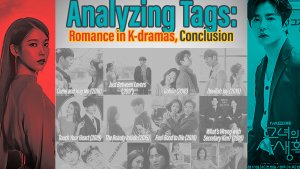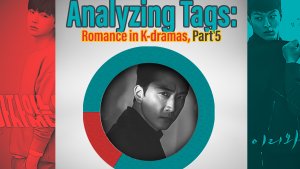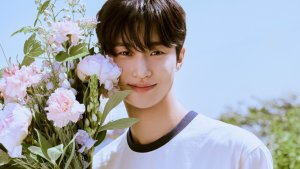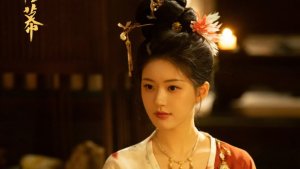 A Tag Analysis: Romance in K-Dramas - Conclusion
A Tag Analysis: Romance in K-Dramas - Conclusion
INTRODUCTION
As per usual when it comes to articles from me, you might've noticed that this is Part 1 of the "Analysing Tags" series. This time I partnered up with @Lua, who helped me gather the data to put this together.
Originally, we planned to do a quick, fun article about tag usage and what it tells us about romance -- styled as an infographic. However, once we realize how subjective tags were, we had to adapt. Only dishing out numbers wouldn't paint a very reliable picture. So we decided to add our interpretation and analysis of the numbers as well.
As it is to be expected, once we picked the data to work with (basically the tags with the highest numbers), the article got a little out of hand. So in the spirit of making this more digestible, we decided to cut it into three parts. Here's an overview of the structure:
Analyzing Tags: Romance in K-dramas | |
| PART ONE (current article) | Will give an overview of the Romance genre and focus on the formulas used in K-dramas and how we can interpret them within the genre. Specifically, we'll go over the following tags: "Love Triangle", "Lead Chasing" and "Age Gap". |
| PART TWO | Will continue the analysis of the formulas used in K-dramas. Specifically, we'll go over the following tags: "Office Romance", "Boss/Employee Relationship," "Cohabitation" and "Childhood Connection". |
| PART THREE | Will focus on the tags related to the characters; specifically how we tag a female lead vs a male lead when it comes to Romance. In addition, we'll also cover the "friendship" tag which includes: "Bromance" & "Sismance". |
And if you're wondering why we're only focusing on Romance, that'll become clear further down below. But before we jump into the numbers, here are some things to keep in mind regarding how we handled the data:
| When we talk about... | We mean... |
*Our compiled list of Most Popular and Highest Rated Dramas | The list is composed of 28 Recent Dramas (2015-2018):
|
| **21st Century Dramas | Completed dramas from 2001 to March 2019. |
| *Recent Dramas | Completed dramas from 2015 to March 2019. |
| **Fairly Recent Dramas | Completed dramas from 2018 to March 2019. |
| *Selected Genres | Since there are too many genres, when we talk about selected genres, we're tallying the dramas under the following genres: Detective, Thriller, Investigation, Romance, Drama, Comedy, Melo, Suspense, Action, Law, Psychological, Mystery, Supernatural, Fantasy/Sci-Fi, Historical, Friendship, and Life. |
Having established that, let's jump into the first part.

The reason we decided to focus on Romance is quite simple: numbers. Unsurprisingly, Romance is the most popular genre in MDL. To give you an idea of just how popular it is, check out the information below:
MOST POPULAR GENREARE WE REALLY SURPRISED? | ||
 | ||
62% of the *Recent Dramas added to MDL from our *Selected Genres are Romance. | ||
72%of the 2018 dramas on MDL are Romance. | From our compiled list of the Most Popular and Highest Rated dramas* 64.2% are Romance. | 50%of the 2019 dramas so far on MDL are Romance. |
 |  |  |
More importantly, the popularity of Romance extends to the tag system as well. So Romance actually makes up the brunt of the number when it comes to tag usage. That's not saying that other genres don't use the same old tropes and formulas; but rather that more viewership increases the chances of a drama being tagged.
Just look at the comparison below:
MOST POPULAR DRAMASHOW BIG IS THE GAP? | ||
 | ||
Boys Over Flowers(the most watched Romance)has been completed by 30,861 more people thanSchool 2013(the most watched non-Romance). | ||
In fact, the top 40 Most-Watched Dramas on MDL are Romance! | ||
| When it comes to Highest Rated, the top 5 may not be romance Dramas... |  | ...but, out of the top 20 highest rated, 45% of them are Romance! |
 |  | |
This meant that, if we wanted bigger numbers, we needed to focus on the prominent tags used in Romance.
[BTW, if you've ever wondered why so many articles focus on romance, this information might give you an idea.]
It's worth noting that Signal, the second highest rated drama (9.2), may not be a Romance, yet it still depicts a love story between Detective Cha (the Female Lead) and Detective Lee (the Second Male Lead). So it could still, technically, be regarded as Romance.
[On an unrelated side note: both @Lua and I rated Signal with a 7.5. If you gave the drama brownie points for its interesting and "original " premise. I'd like to point out that back in April of 2000, a movie came out called Frequency which uses the same premise but results in a MUCH better story.]
Anyways, enough about that. If you're also wondering why we stuck to K-dramas rather than include all countries, well there are two reasons:
- If we'd included all countries, the analysis to be done would've been overwhelming.
- We mostly watch K-dramas, which meant that we wouldn't be able to properly analyze trends, patterns, and content of other Asian dramas.
I hope that gives proper reasoning behind our choices. Now that we've established that Romance is the most popular genre, we can study the tags and their patterns and correlations.
TAGS & CONTENT
The idea behind this article is to find the most used formulas within romance dramas as told by the tagging system. So let's start with arguably the most obvious.
LOVE TRIANGLEHOW COMMON IS IT, REALLY? | ||
 | ||
Only 18.5% of the **Fairly Recent Romance Dramas have been tagged with a Love Triangle. | ||
| Keep in mind, we are using the term "Love Triangle" as defined by the MDL tag: | "The depiction of a romantic attraction or relationship involving three people." So even if one party is harbouring an unrequited love (a tag in and of itself, which we didn't include here), that drama might've still been tagged with a "Love Triangle". And if it did, we've considered it in our numbers -- regardless of how each of us may interpret it; whether that be as a: angle, square, unrequited love, etc. | ||
| In general, men pining for a woman seems to be more popular... | From our compiled list of the Most Popular and Highest Rated dramas*almost 50%are tagged with "Love Triangle". | ...than women pining for a man; though we might get the occasional double triangle or Square. |
 |  |  |
 |  |  |
While "Love Triangle" is the most used tag within the romance genre, the trope may not be as prevalent as we think. However, it's important to consider that MDL implemented the tag system around October 2017. Therefore, many dramas prior to that have few to no tags. This opens up the possibility that "Love Triangles" used to be more popular but its use has been decreasing ever since. The only real way to find out would be to have everyone tag the missing shows. (Anyone up to the challenge?)
Nevertheless, within our *compiled list of top rated and most popular dramas, almost half of them (13*) portray this trope. Which means that if someone were to watch dramas based on popularity, he/she might come across a lot of shows with this plot device. Ergo, perpetuating the feeling that "a lot of k-dramas feature a love triangle."
*BTW, in the graph above, notice we've marked Descendants of the Sun as undefined. That's because we aren't sure whether the drama includes it or not. On the one hand, someone tagged the show. On the other hand, based on reviews and a couple of articles, there seems to be disagreement on whether it has a proper "Love Triangle". Since neither @Lua nor I have seen it (full disclosure: I dropped it), we couldn't weigh in on the issue. So keep in mind that this article is still heavily based on our opinion and interpretation of the numbers; as well as the accuracy -- or lack thereof, of the tags.
 | Another interesting observation is that based on what we've experienced -- since we don't have actual data save for the small sample of our compiled list -- most "Love Triangles" seems to involve two men fighting for a woman's affection. The most infamous one is probably Jealousy Incarnated. Not only was the "Love Triangle" drawn out, but if you take it out, you'd be left with almost no plot. Certainly not enough to fill 24 episodes! |
Yet very rarely do we see only women fighting for a man's affection. And we're emphasizing the only aspect here for a reason. From our scouring the site, popular dramas where this applied were: | |
Oh My Ghostess (2015) | The K2 (2016) |
 |  |
With viewers especially praising the latter as one of the few dramas where the 2FL out-staged the FL; to the point where it provided the audience with a dose of "Second Female Lead Syndrome" for a change! | |
However, out of the **fairly recent romance dramas, we saw none were two women fought for one man. Instead, we got cases of simultaneous "Love Triangles" (a.k.a. Squares, although we didn't include the dramas tagged as such).
Prominent examples of this scenario are She was Pretty, The Third Charm and My ID is Gangnam Beauty. In these, the ML and 2ML pinned for the FL; while the FL and the 2FL pinned for the ML. And even then, the ML seemed much more involved in trying to get the FL's attention than the other way around.
Interestingly enough, in Mama Fairy and The Woodcutter, the FL and 2FL pinned for the 2ML's attention; while the ML and 2ML pinned for the FL's attention. This stands out as another rare case.
So now that we've covered love triangles, let's move onto another heavily requested formula in the forums.
CHASINGIN THE PURSUIT OF LOVE, WHO CHASES WHO? | ||
 | ||
Out of the 463 *Recent Romance Dramas, only 14.5% portrays one lead pursuing the other first, with the others left undefined. | ||
2 out of 3*Recent Romance Dramas will have the male chasing the female first. | From our Compiled List of the Most Popular and Highest Rated dramas* | **Fairly Recent Romance Dramas show an even splitbetween the tags. |
 |  |  |
 |  |  |
Given that Romance is mostly marketed towards the female audience, it comes as no surprise that the number of "Male Chases the Female First" would outweigh the opposite scenario. Having a woman (even more so if she's the lead) chase a man around seem to "lower her worth" in the eyes of many viewers. Which makes you wonder about the double standard, right?
If a man chases a woman it's because he's interested and confident. But if a woman chases a man she's harshly regarded as weak and desperate. Now, there is no actual data to support this statement. Psychologically speaking, people tend to be more vocal when it comes to negative things. There's a reason the media focuses on the "bad" (it just sells better and more). So it might also be that, while many don't mind a woman pursuing a man, they aren't as vocal in the comments as those who dislike the scenario.
At the very least, most dramas were left undefined, which means it doesn't make it very clear who fell in love with whom first (or nobody tagged them). Those dramas might go down a more natural and perhaps realistic route of having both characters develop feelings for each other simultaneously.
Personally, I prefer dramas where the leads "walk towards each other"; both equally active in their desire to be together. This formula not only lowers the chances for an unhealthy relationship, but it values both characters' desires equally.
After all, sometimes the "one chases the other around" formula can verge into unhealthy territory, where one lead forces his/her feelings on the other. Dramas like Noble, my Love, Secret Garden and Boys Over Flowers comes to mind whenever I think of male leads aggressively pursuing the female lead.
Oh My Ghostess (2015) | |
However, in the spirit of equality, Oh my Ghostess also shows a female lead aggressive in her pursuit. Just look at these two scenes where Sun Ae (2FL, inhabiting Bong Soon's -- the FL's -- body) is trying to "bed" Seon Woo (ML). | |
 |  |
As fun as they are, switch the genders and re-evaluate them. Doesn't that turn a hilarious situation into something creepy and concerning? | |
Now, don't get us wrong, we aren't judging if you've enjoyed the shows we've mentioned. Dramas are fiction built for the sake of entertainment, after all. So some leeway is to be had. However, it's always good practice to be aware of what is questionable even if we still find it hilarious and/or desirable.
And since we've already treaded into controversial water, let's swim deeper into it, shall we?
AGE GAPWHICH IS MORE POPULAR, THE RHINO OR THE COUGAR? | |||
 |  | ||
From the **Fairly Recent Romance,only 10%have an age-gap related tag. | Romance dramas represents87.4%of the age-gap related tags. | ||
Which means that only a few dramas involve an age gap worth tagging. | Which means viewers regard an age gap as an important factor of a Romance drama. | ||
GENERAL "AGE GAP" TAG VS SPECIFIC "GENDER" TAG | |||
 | |||
"Older W/Younger M" represents the majority of the dramas tagged with "Age Gap" AND with a Gender-Specific tag. | Which means that an older man dating a younger woman in a drama is 3x LESS likely to be tagged. | ||
 |  | ||
It's important to note that the "Age Gap" tag represents a smaller number of the overall age-related tags. Instead, the brunt of the number is composed of the tags specifying the gender of the Older/Younger characters. And even then, we come across some limitations created by the vague description of the tags:
Older Woman/Younger Man: "A material depicting a female character that is older than a male character."
Older Man/Younger Woman: "A material depicting a male character that is older than a female character."
Notice how this doesn't specify romance at all. However, based on observation of which dramas got tagged, I'd say most people use it in regards to the age disparity between the leads (whether that applies to the actors or their characters differ from case to case).
If so, the data indicates that viewers are more likely to tag a drama if it portrays an older woman dating a younger man, than the other way around. That's not to say that these types of dramas are more prevalent, but rather that they stand out because they go against the traditional standard.
So the low numbers when it comes to an older man dating a younger woman, might be the result of people only tagging when there's a significant gap; whether that determined by the characters supposed age and/or by the actors' real age. Even then, though, some dramas might slip by untagged.
Prominent examples of a significant age gap between the actors include:
| Tagged? | Drama | Age Gap: actors | Age Gap: characters |
| ✔ | Goblin | 12 years | 600-800 |
| ✔ | Mr. Sunshine | 20 years | Obvious but unremarked |
| ✔ | Prime Minister & I | 20 years | Unknown |
| ✘ | A Beautiful Mind | 15 Years | Obvious but unremarked |
| ✘ | Terius Behind Me | 14 Years | Obvious but unremarked |
| ✘ | Black | 15 Years | 1-2 years maybe (flashbacks show them similar in age). |
Notice how many shows were left untagged probably because the writers didn't focus on the age-gap and made it a conflict. Whereas, because an older woman dating a younger man isn't the standard, people would tag it even if the gap is fairly small. Though some dramas might slip by without being tagged, chances are that even a small gap will be noteworthy.
Prominent examples of such dramas include:
| Tagged? | Drama | Age Gap: actors | Age Gap: characters |
| ✔ | Healer* | 2 years | 1-2 years |
| ✔ | Lucky Romance | 2 years | Unknown |
| ✔ | 4 years | Unknown | |
| ✘ | Thirty but Seventeen | 3 Years | Same age |
*Healer, however, is a complicated case. While it was tagged with "Older Woman/Younger Man" and there's a small gap between the leads, it might've also been used in reference to other relationships within the drama:
*Healer (2014) | |||
| Characters | Age Gap | Relationship within the drama | |
 | Jung Hoo | Min Ja | 24 years | Work partners and something of a surrogate family. |
 | Moon Ho | Myung Hee | 10 years | Moon Ho had a crush on her since he was a child. |
 | Han Chul | Min Ja | 10 years | Min Ja was his mentor and they hint he may have harbored a crush on her. |
That's not to say that there aren't any "Noona" dramas with a significant age gap between the romantically-involved leads! Prominent examples include:
| Tagged? | Drama | Age Gap: actors | Age Gap: characters |
| ✔ | Romance is a Bonus Book | 11 years | Unspecified, but remarked upon |
| ✔ | Witch's Romance | 19 years | Unknown, but is a big conflict |
| ✔ | Secret Love Affair | 19 years | Unknown, but is a big conflict |
Of course, the tag system is implemented on a user-by-user basis. Which means that anyone can tag a drama with whatever they want and however they perceive it. This opens up an alternate explanation for why some dramas got tagged while others do not. As I mentioned before, it may have to do with how prominent a concept the age gap is within the drama.
In Witch's Romance and Something in the Rain (age gap of 6 years), the age gap is introduced as a conflict that the female characters must overcome. As such, we are repeatedly reminded of it, which increases the chances of someone tagging it.
Meanwhile, dramas like Terius Behind Me, Twenty Again (with a gap of 6 years), and A Beautiful Mind don't even bring up the issue up at all, despite the obvious difference in age between the actors.
Having said that, we must still take this data with a grain of salt, for when it comes to a human element, we'll always get a few discrepancies.
After all, if we argue Goblin got tagged because of the vastly different ages between the characters, then by that same coin, A Korean Odyssey should've also been tagged, right?
Goblin (2015) | A Korean Odyssey (2017) |
 |  |
 |  |
 |  |
Let's remember that in A Korean Odyssey, Son Oh Gong (the ML) first meets Jin Seon Mi (the FL) when she was a little girl. Of course, unlike Goblin, the actors only have a one year gap, which might've made it feel less important and/or easier to overlook.
But what about the general "Age Gap" tag in You Who Came From the Stars? This one is another complicated case because while actress Jun Ji Hyun is 6 years older than Kim Soo Hyun, the characters they play are another story.
You Who Came from the Stars (2013) | |
 |  |
 | Do Min Joon (the ML) is an alien who came to earth 400 years ago. He even met Chun Song Yi (the FL) when she was a child, and reunited with her 12 years later. So who is the age gap referring to...? The characters? The actors? Both? |
Perhaps a bit belatedly, but it's worth noting that the "Age Gap" tag has been defined as:
"An age disparity between couples or friends."
This suggests that even when filtering through romance, some dramas might slip by with a tag that doesn't correspond to the main couple.
So keep in mind that if there's an age difference between two characters (who could be friends, co-workers or partners) and the drama just so happens to be a "Romance," it was included within the numbers. So we might've gotten a bigger margin of error in this last section than with the ones prior.
Anyways, that's it for Part One of our series! We hope you enjoyed it and found the data as interesting as we did.
Thank you for reading this article!
We'd love to hear your thoughts in the comments down below. Here are some questions to get a conversation started:
- Did you enjoy the article?
- And if so, which subject did you enjoy the most?
- Do you agree or disagree with our interpretations?
- Which data did you find most surprising?
- Do you agree there's a double standard when it comes to "age-gap" & "lead chasing" related tags?
- Have you ever tagged shows? Why or why not?
- Have you ever removed a tag? Why or why not?
- If you do tag: which tags do you use the most?
- Would you rather shows be tagged with general/umbrella terms or specific terms?
- Did you know you can vote for which tags better represent a show from the ones added? If so, have you ever voted on a drama?
- Have you ever come across a drama with a tag you felt wasn't accurate?
- Have you ever searched for a drama through tags? If so, which tags have you filtered your search through?











